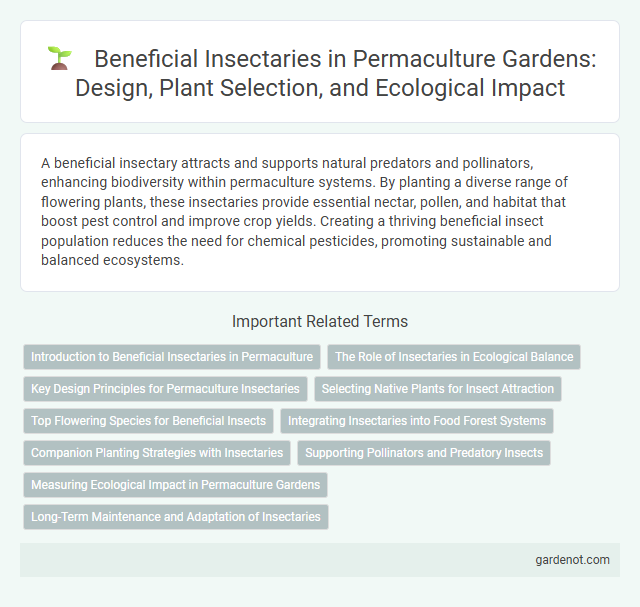A beneficial insectary attracts and supports natural predators and pollinators, enhancing biodiversity within permaculture systems. By planting a diverse range of flowering plants, these insectaries provide essential nectar, pollen, and habitat that boost pest control and improve crop yields. Creating a thriving beneficial insect population reduces the need for chemical pesticides, promoting sustainable and balanced ecosystems.
Introduction to Beneficial Insectaries in Permaculture
Beneficial insectaries in permaculture are strategically planted habitats designed to attract and support beneficial insects such as ladybugs, lacewings, and parasitic wasps that naturally control pests. These insectaries provide essential resources like nectar, pollen, and shelter, enhancing biodiversity and promoting ecological balance in gardens and farms. Integrating diverse flowering plants like dill, fennel, and yarrow optimizes the habitat, reducing the need for chemical pesticides and improving crop health.
The Role of Insectaries in Ecological Balance
Insectaries plant diverse flowering species to attract beneficial insects such as pollinators and natural predators, enhancing pest control without chemical interventions. These habitats increase biodiversity, supporting ecological balance by promoting predator-prey relationships that regulate pest populations naturally. Integrating insectaries in permaculture systems improves crop yields and sustainability by fostering resilient ecosystems and reducing reliance on synthetic pesticides.
Key Design Principles for Permaculture Insectaries
Permaculture insectaries are designed to attract and sustain beneficial insects by incorporating diverse flowering plants that bloom sequentially throughout the growing season, ensuring continuous nectar and pollen sources. Strategic placement near crops maximizes pollination and natural pest control, creating a balanced ecosystem that supports biodiversity and enhances soil health. Emphasizing native plant species and structural diversity fosters habitat complexity, which promotes resilient insect populations essential for sustainable agricultural productivity.
Selecting Native Plants for Insect Attraction
Selecting native plants for beneficial insectaries enhances ecosystem balance by supporting local pollinators, predators, and parasitoids essential for pest control. Native species such as goldenrod, milkweed, and coneflower provide nectar, pollen, and habitat tailored to indigenous beneficial insects, boosting their survival and efficiency. Integrating diverse native flora in permaculture gardens promotes robust insect populations, improving pollination rates and natural pest regulation.
Top Flowering Species for Beneficial Insects
Top flowering species for beneficial insects in permaculture include yarrow (Achillea millefolium), fennel (Foeniculum vulgare), and cosmos (Cosmos bipinnatus), which provide essential nectar and pollen sources. These plants attract a diversity of pollinators and predatory insects like ladybugs and lacewings, enhancing natural pest control. Integrating flowering species such as dill (Anethum graveolens) and buckwheat (Fagopyrum esculentum) supports habitat complexity and increases beneficial insect populations critical for ecosystem balance.
Integrating Insectaries into Food Forest Systems
Integrating beneficial insectaries into food forest systems enhances biodiversity and promotes natural pest control by attracting pollinators and predatory insects. Planting native flowering species such as yarrow, fennel, and dill supports the lifecycle of beneficial insects like ladybugs, lacewings, and parasitic wasps. This ecological approach reduces the need for chemical pesticides, improves crop yields, and fosters a resilient, self-sustaining permaculture ecosystem.
Companion Planting Strategies with Insectaries
Companion planting strategies with beneficial insectaries enhance pest control by attracting predatory and pollinating insects, such as ladybugs, lacewings, and parasitic wasps, which naturally regulate harmful pest populations. Integrating flowering plants like alyssum, marigolds, and dill creates habitat and nectar sources that support these beneficial insects, improving crop health and yield. This ecological approach promotes biodiversity and reduces reliance on chemical pesticides in permaculture systems.
Supporting Pollinators and Predatory Insects
Beneficial insectaries enhance permaculture ecosystems by providing habitat and nectar sources for pollinators such as bees, butterflies, and hoverflies, which are essential for plant reproduction and crop yields. These insectaries also attract predatory insects like ladybugs and lacewings that naturally control pest populations, reducing the need for chemical interventions. Integrating diverse flowering plants that bloom throughout the growing season supports continuous food availability and shelter, fostering a resilient and balanced garden environment.
Measuring Ecological Impact in Permaculture Gardens
Beneficial insectaries in permaculture gardens significantly boost biodiversity by providing habitats for pollinators and natural pest predators, enhancing ecological balance. Measuring ecological impact involves monitoring insect population dynamics, pollination rates, and pest suppression efficiency using standardized biodiversity indices and regular observational surveys. Data-driven assessments reveal improved soil health and plant productivity, validating the role of beneficial insectaries in sustainable ecosystem services.
Long-Term Maintenance and Adaptation of Insectaries
Beneficial insectaries require long-term maintenance through regular monitoring of plant health, supporting diverse flowering species to provide continuous nectar and pollen sources, and managing habitat conditions to sustain insect populations year-round. Adaptive management involves adjusting plant compositions based on seasonal changes and pest pressures, ensuring resiliency and ecological balance in the permaculture system. Continuous observation and responsive interventions enhance insectary effectiveness, promoting sustained pest control and pollination services.
Beneficial insectary Infographic

 gardenot.com
gardenot.com